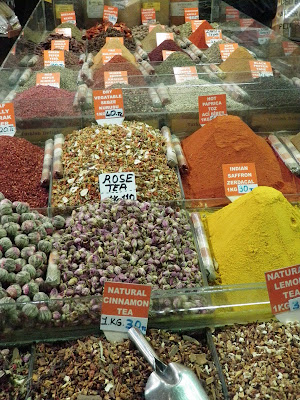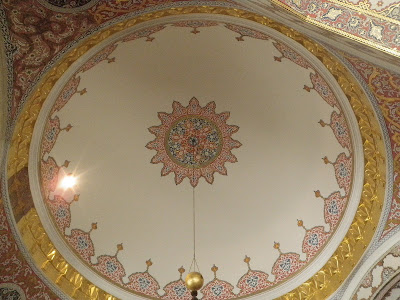Turkey is most definetly the dividing line between Europe and Asia. Demographically speaking, the country is divided into two continents : the west is European, the east, Asian. As a matter of fact the rover Bosphorus in Istanbul is the dividing line between Europe and Asia. We spent a bit of time on the Asian side of Istanbul and really, it's the same as its European side of the city.
Crossing the Bosphorus river to get from Europe to Asia
As soon as we spent our first day in Istanbul, we could tell that we were treading on the Asian line. Turkey is much more Asian than European (although many Turks would wince at me saying this). What I mean by that is that there are no price tags, haggling is the norm, supermarkets are few and far between (want some gloves? Go to the glove store! Want a knife? Go to the knife store! Want some cheese? Go to the cheese market!) and everyone is always trying to sell you on their stuff. This is not only because we are tourists butjust in general. Turks do it to Turks ! They'll stand in front of their shop yelling out what they are selling as well as their prices. And you need to negotiate prices for anything you buy. Especially if you're a tourist. For example, yesterday Chris and I bought some vegetables for a salad. The price started at 7TL and we settled for 3TL. A little exhausting, but consider it our prep for India.
Streets of Istanbul. Get ready to haggle !
Skills
Istanbul is the city of color. . So many beautiful shades of colour, everywhere you look. This city is a photographer's dream. Every city has its bazaars (market) and Istanbul had the largest. First there is the oh- so-famous (yet tacky and touristy) Grand Bazaar. It is one of the largest and oldest covered markets in the world. It covers around 60 streets and has about 1200 shops (souvenir items, clothes, jewlery, carpets...), and you can bet your arasta that you'll get lost in it. There are so many arched pathways, some are VERY narrow, that you tend to lose track of where you've turned and what stalls you've passed by already.Getting lost amidsy thousands of shops at the Grand Bazaar. Whe never even knew we had so many friends with carpets until we walked through here ! ("hello my friend! Would you like a carpet?")
We both wish we could pack more breakables in our backpacks.
And then there's my favorite place to stroll around in Istanbul: The Egyptian Bazaar (aka spice market). This place smells wonderful ! Cumin and saffron and turmeric oh my ! The colors there are just amazing with great big sacks of orange and yellow and red spices as well as seeds and other magical ingredients (such as Turkish viagra) hanging from above.Can I get a little baggie of each please?
A buffet of Turkish delights ( lokum)
One of the main differences between Turkish common sights and those of the rest of Europe is the mosques that you see spotted everywhere. They are beautiful, majestic, cozy, intimidating and open to all. There is nothing like walking into a mosque (head covered, no shoes, of course!) and admiring the prayer mats / carpets covering the ground, or the arches and pillars and tiles decorating the walls. To add to these beautiful places of worship is the adhan : the Islamic call for prayer blaring out from hundreds of minarets in the city all at the same time, summoning Muslims to mandatory prayer. The adhan is sung 5 times a day so it is a very common sound in Turkey.
Another common sight next to mosques are seated faucets, as Muslims must wash their hands, feet and head before prayer time.
We were told we HAD TO SEE the Aya Sofya, the church that reigned as the grandest church in Christendom during the Roman Empire. We thought it was overated. I mean, it IS a massive bulding, supported by 40 massive ribs and a gigantic dome that makes the St.Peter's Bisilica look like a bump. It's so big, the Statue of Liberty could stand underneath it and have 32 feet to spare. It had Only 2 years after they finally finishd bulding this massive dome it fell, being vulnerable to a powerful earthquake. Once the Roman Empire was booted out by the Ottoman empire, he declared it a mosque. Now, it's a museum but really, the name is the onlt sign that told us it was. The only museum-ish thing about it were the pictures displayed, even if they were picyires of the inside of Aya Sofya, So, if you can't see very well, they showed you, with pictures, what the building you were inside looked like. Thanks. We did appreciate some of the mosaics that were inside the "museum" but personally, I much prefered the Blue Mosque, which stood right across it and was built specifically to rival the Aya Sofya.
The Aya Sofya
Inside the Aya Sofya
Big ones
Mosaics, supposedly some of the world's finest !
One of the most famous (and beautiful) mosques in Istanbul is the famous, and enormous, Blue Mosque. It is one of the most defining sights of the Istanbul skyline, with its enormous dome, seven minarets and of course, blue colour. This mosque once challenged the importance of Mecca's mosque (which also has six minarets). This started a huge scandal which eventually resulted in the sultan building a seventh scandal. Just to give you an idea of how big this mosque is, about 21 000 tiles were used to decorate it. Speaking of grandiose buildings, we decided to visit what is known as the Versaille castle of the Ottoman Empire, the residence of past sultan's : Topkapi Palace. The building has been conerted into a large museum, where many jewels are held, including a jewelery chest full of emeralds that I am ecpecting for Valentine's Day, and the world's 5th largest diamond (which was discovered in a dumpster by a beggar and then sold to a jewelery dealer for pennies. Conspiracy !). We also saw (supposedly...prove it) pieces of prophet Mohammed's beard, Moses' walkinf staff, Joseph's turban (yeah, like Jesus' dad!) and other things that left me skeptical, yet still amazed. Security was tight but Chris is one stealthy mofo.
The palace gates. This entrance would often display the decapitated heads of uncooperative administrators or rebels as a warning to all of those who entered. Actually, one of his victims was Vlad the Impaler (known as Dacula). He was impaled here.
Colorful mosaic walls fill the palace walls.
Decorative tiling in domes.
Chris' secret photos of Joseph's turban. Oh, snf that narrow metal thing on the right has a decomposing arm in it. It's St. John the Baptist's arm. Do YOU believe it?
Traditional Turkish armor.
The Islam crescent. Such an important symbol in Turley (which is why it's on the flag)
We've had the opportunity to try many Turkish sweets and drinks (we will mention more in later blogs). Doner kebaps (yeah, the big hunka meat that you see rotating in the windows) and kofte (spicy meatballs) are Turkish favorites that Chris has been throughly enjoying. Kabap and kofte joints are everywhere. They're even more numerous than Starbucks at a trendy university New York area.
Chris and Uros enjoying a kebap at a bazaar (well, Chris downed his before I got a chance to take a pic).
Tea (known as cay, pronounced chai) is not so much a national drink as it is a ritual. They serve it in tulip shaped glasses and it is served every minute of the day. Going into any shop you are bound to be asked "would you like a cay while you try on those shoes?" or "would you like a cay while we bargain for a T-shirt?". A regular sight in Istanbul is Turks walking around the streets with trays full of these tulip glasses, going from one shop to another. Cay stops the clock's hand and is a simple reminder of the importance of taking a moment just to sit, drink and let some of the day pass you buy. Never say no to a cay. It's unheard of, and well, a little rude. Lovin' the cay.
As for sweets, Chris LOVES the gooey Turkish delights, known as lokum, made of cornstarch, nuts, syrup and an endless variety of flavorings. It's one of those you either love em or hate em treats. I myself prefer to stand outside patisseries and drool over the Baklava.
And then there's halva the sweet traditional comfort food modetly sweet made of sweet semolina, pine nuts and butter.
Havla
There is so much to talk about when it comes to Turkish cuisine and drinks. We could write a whole blog about. Instead, we'll put in a few bits about it as we keep jouneying around the country.
My ultimate favorit experience was being witness to a whilring Dervishes dance performed by the Sufi & Sema Foundation. Dervish sects began appearing in Islamic countries in the 9th cenury with beliefs and customs as fantastic as snake eating. Some dervish sects required their followers to maintain absolute secrecy to avoid having people join for hypocritical reasons. They were eventually outlawed but today are ganing increasing popularity.There are many dervish sects worldwide that perform similiar rituals, but the Turkish sects are known to have the purest and smoothest, and they WILL bring you to a trance-like state. The dance consists of the hafiz, who knows the entire Quran by heart, who summons the dervishes. They come in with their cloaks (symbolizing their tombs), and drop them, showing their white and light colored robes, (representing their shrouds). One by one, they begin whirling, and whirling and whirling. By holding their rights arms up, they receive the blessings of heaven which are passed down to the earth by their hands, pointing to the ground. The whirling was so smooth that if you only looked at the top half, they seemes to be on a steady pirouette. They whirled entire songs (played by a traditional dervish band) and then walked in a line (no wobbling!) , waited, and began the ritual again.
The band. The man third from the left is the hafiz
After spending a week in Istanbul, we were ready to move on. We got a small taste of the Turkish culture, a culture that we were going to further discover for the next month and a half. Istanbul is a bustling city of colour, noises, songs, sights and smells, and filled with people who are willing to share their story, culture, views and way of life. But first, would you like a cup of cay?
































Great blog, Renee. It looks like an amazing trip!
ReplyDelete-Ashley Jensen from Bonnyville :)
Great pics and story. So good to talk to you on Sunday.
ReplyDeleteWOW - lots of amazing new adventures. THE cay looked appealing - as did the halvah. Another world!!!
ReplyDeleteAwesome pictures!
ReplyDeleteI have a question about the Turkish armor photo. Do you happen to have any other photos of it/know what the museum was/what the description and time period ascribed to it is?
I know this sounds to be an odd question, but I'm currently working on my senior thesis and have been trying to find good quality pictures of medieval Turkish and Persian armor to reference for my thesis.
Thanks,
Ashlen
Stetson University
TO ASHLEN
DeleteI SAW THAT BLOG RIGHT NOW AND REALIZED U ASKED UR QUESTION LONG AGO,JUST WANTED TO SAID IT WAS ARMOUR OF MUSTAFA THE THIRD(THE REIGN IS FROM 1757 TO 1774)BUT IT WAS NOT A COMMON ARMOR.I MEANT A PRIVATE ARMOUR FOR SULTAN THATS THE WHY THEY USED GOLDEN BUTTONS AND VALUABLE STONES AS WELL.U HAVE TO VISIT TURKEY ONE DAY AND WHEN U WALKING IN TOPKAPI PALACE U CAN SEE EVERYTHING WITH UR EYES